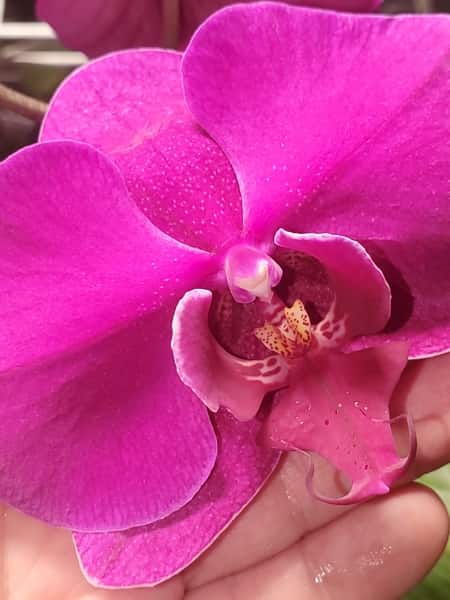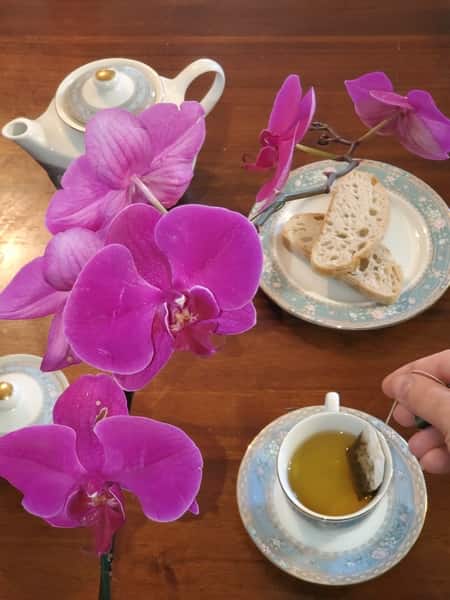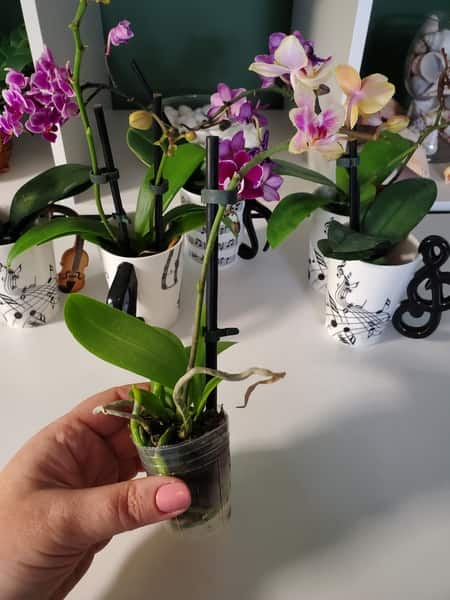Warm growing orchids prefer the higher temperatures, light, and humidity that most closely relate to tropical and subtropical climates year-round. That means at night, the winter temperatures don’t drop below 64ᵒ F (17.7ᵒ C) and during any season during the day, they remain steady around 70ᵒ F to 90ᵒ F (21ᵒ C to 32ᵒ C) in sun.

All Rights Reserved
In their natural habitat, these orchids do see a slight temperature variation along with a diminished light, so we need to mimic those conditions when cultivating them indoors.
Heating mats for orchids simulate these conditions and facilitate cultivating orchids in winter.
Why would I need a heating pad for orchids?
Bottom heat on orchids during the winter months is proven to be a necessity for warm-growing orchids and not just a luxury.
The best way to provide heat for orchids year-round is with a heating pad for orchids. By increasing the moisture and evaporation after watering, a heating mat placed under the orchid’s pot will raise overall relative humidity (rH) in the environment. Seedling mats for orchids also induce root growth and supply perfect conditions for orchid seedlings to thrive until they are more mature plants.
Which Orchids Would Benefit Form A Heating Pad?
Bottom heat for orchids is necessary to promote constant growth during the year for warm-growing orchids. Warm-growing orchids include Vandas, Cattleyas, most Dendrobiums, and summer-blooming Phalaenopsis. The Phalaenopsis orchids you purchase at the local grocery store which usually come without an ID tag are most likely to be a cool growing Phalaenopsis, or winter-blooming Phalaenopsis.
Warm-growing Phalaenopsis are found closer to the equator and not as high in altitude, producing vibrant colors. They’re harder to come by in supermarkets and require specific care, like elevated humidity.
Be sure to research your orchid’s ID with the species, looking into the temperature preferences and where it grew naturally before it was commercialized, searching for both temperature, altitude, and humidity recommendations.
If you don’t know if your orchid is warm-growing and you’re not sure whether or not to buy a heating pad for orchids, then check your climate indoors. If you have to turn the heater on during winter, then it’s probably a good sign to get a heating pad. The heat from the central heating unit in your house will be way too dry. (Your orchids shouldn’t be by a vent anyway.)
If the climate indoors is warm enough for you, your orchids will be fine without a heating pad. In this case, you’ll need to check the temperature and light, and you’ll be set for the winter season.
Orchids Grown in Clay Pots and Semi Hydroponically will Benefit from a Heating Pad
It’s not only about which orchid you cultivate, but how. Warm-growing orchids will benefit from a heating pad all year-round if they’re on mounted on or planted in terracotta pots.
Orchids that grow in clay pots are already in a cooler environment since the terracotta pot will bring the temperatures down considerably. By the way, mounting on terracotta pots is an incredible experiment with cool-growing orchids. You need to try it sometime. Semi hydroponics (or even FWC for that matter) will also benefit from a plant heater underneath them.
They already have no outer protection from the colder months, just a thin, glass vase.
The evaporation during the winter proves to be too cold for most Phal’s roots.
By keeping a heating pad under them, the orchids will benefit from the extra heat source.

All Rights Reserved.
Heating Pads Promote Evaporation and Orchid Root Growth
When providing extra heat, the water that is inside the pot will evaporate faster. There is nothing worse than having cool, stagnant water inside the orchid pot, especially during winter. With the extra heat that is provided from the bottom, the water droplets evaporate and consequently increase the humidity in the environment.
Most warm-growing orchids (and intermediate growing orchids, too) prefer higher humidity climates. This will either call for a humidifier or a humidity tray. A heating pad can simulate the same benefits by promoting constant evaporation.
Warm temperatures also stimulate root growth. May plant growers will run hot water tubes under the plant tables. It has already been proven that the higher temperatures promote roots to grow, so this information is not exclusive to orchids.
It’s not necessary that the environment that heats up, but the ground under the orchids. This means that the roots will feel the heat and grow more vigorously. The foliage will not benefit from the heat since the leaves can burn from high temperatures. (It’s also expensive to heat up an entire room, as compared to just the bottom of orchid pots.)
Will a Heating Pad Interfere with the It’s Natural Cycle?
The higher temperatures signal to the orchid that the ground is heating up—time for spring. Time to bring on new roots and grow again after the harsh winter.
Of course, in their natural habitat, warm-growing orchids wouldn’t be going through a harsh winter, but the temperatures would still raise a few degrees. It’s hardly noticeable, but the raise in humidity is very noticeable.
When I lived overseas, it rained every single day for six months straight.
A heating pad for orchids is a necessity because it both raises the temperature in the “ground” and also raises the humidity around the leaves, due to evaporating the water contained inside the potting medium.
All three of these signs, light, humidity, and temperature, signal to the orchid what season it is and when it should bloom. Without a heating pad, your orchid has a chance of not interpreting those signs well and won’t bloom.
Heating Mats for Orchids aren’t the Only Winter Adaption You’ll Need
The heat and light that comes through the east window during winter seasons probably will not be enough—again this depends on where you live. If you intensify the light and heat during the winter, the better your warm-growing orchids will thrive.
The warm-growing orchid’s roots develop faster and stronger when they’re provided with heat from under them during the winter, but htey also need more humidity and adaptations with the light levels.
When I lived overseas in Brazil, it was hard even to tell what season it was. We had practically only two seasons: rainy season and dry season. Besides the increase in rainfall (high humidity and more water), the main indicator seasons changed was the slight increase in temperature. Before you crank the heating pad on high, just a note: temperature variations weren’t drastic like they are in Kansas. Just a few degrees should do the trick.
Summarizing: to keep orchids alive in winter, you’ll need to adjust the lighting, temperatures, and the humidity.
Do I keep the heating pad for orchids on all day and night?
Please don’t leave the orchid heater on all day and night. Even though warm-growing orchids love to see the higher temperatures, they still need fluctuation during seasons and also during day and night.
Cattleyas, for example, don’t like to see that decreased drop in temperature during winter. I don’t keep my thermostat on too high, so it’s considerably colder. I’m not referring to the day/night temperature drop of 10 degrees (both F and C) which is appreciated, but the overall drop in winter seasons.
In summer, my home office is considerably hotter than in the winter. I’m not about to sit in a 90ᵒ F (32ᵒ C) office just so my Cattleya will thrive. I’d prefer to just warm them and not me.
Turning on the heat mat and walking away for weeks on end will only create a microfauna perfect for fungus and bacteria. Heating pads are quite inexpensive and their efficiency outweighs their low price, but that doesn’t mean you can leave them on forever.

To make the most out of providing bottom heat for orchids, you will need to increase your watering by a tad bit.
Heat dries out the potting media.
You’ll also need to increase air circulation when using a heat mat for orchids, just to avoid any extra bacteria lurking around in hot, humid places.
TIP: Slightly increase the temperatures during summer and greatly supplement them in winter, but always maintain a slight temperature drop at night.
Is a heating mat for orchids all I’ll need?
Unfortunately, no. At least in Kansas, the window light doesn’t quite meet all the necessary light requirements, but you’ll have to check for your region. If you grow orchids indoors, you’ll need to either supplement the natural light during the short winter days or buy an artificial light.
If your orchid is slow to bloom, insufficient lighting may be the cause. If you want recommendations, this is the grow light I use (Affiliate Link). But this is an entirely different article, and if you want to know general requirements for lights, this article of light requirements is a good place to start.
But this is an entirely different article, and if you want to know general requirements for lights, this article of light requirements is a good place to start.
One note on growing orchids in winter is that the light will need to be a few hours less than it is in summer, but don’t go overboard. Just two hours is enough. 10-12 hours in winter, 12-15 hours in summer.
What should you look for in a heating pad for orchids?
Please don’t say that any old heating pad will do. There are some items that you need to be aware of when purchasing an item that provides bottom heat for orchids. The best heating mat for orchids will be waterproof, have ample surface area, and have manual temperature selection.
Being waterproof eliminates the majority of the heating pads that are sold on the market. A pet’s heating pad ( as in sold for dogs and cats) is also not recommended just because they aren’t waterproof. The same goes for most heating pads for humans used for health or relaxation issues.
Orchid pots will drip constantly. Water splashes over everything. It’s a royal mess.
Water and electricity do not match, so make sure whatever heating pad you buy says specifically waterproof. Don’t use anything that is water-resistant either. Water-Resistant and Water-Proof are two very different categories.
Also, a heating pad that remains the same temperature year-round will not provide a slight fluctuation to signal to the orchid the correct seasons. This is why you need a controller to adjust the temperature during the seasons.
I don’t have to use the heating pad in summer, but depending where you live, you might have to. There are some brands of heating pads for orchids that do not have a controller, but will heat up to 6ᵒ to 10ᵒ degrees (both F and C) from the ambient temperature.
This is not recommended, since you won’t be able to control it (unless you unplug it every other hour).
The last item, having ample surface area, is so you don’t remodel your whole orchid shelf every time you water. Get one large enough to fit all your orchids and all the orchids you plan to buy in the future. An addiction is an addiction, so make your mat larger enough to fit at least double of the orchids you have now.
How to Use a Heating Pad for Orchids
It might be tempting to place the orchid pot directly on the mat. You can make your own inverted orchid pot and place the real pot over it. I’ve seen it done several ways: directly on the mat, wrapped in foil, on top nursery trays, and every other idea in between. I can’t give a personal opinion here because I’ve only tried placing them directly on the mat. I’ve read that it’s best to use a nursery tray or some other device in between the mat and the pot, but again, I can’t confirm that.
All of the authors stood by there findings, so I guess if you have a mat, that’s what’s really important. The rest is a grain of salt…
If you’re wondering, I bought this heating pad from Amazon (Affiliate Link) and it’s the one I use in winter with all my Cattleyas.
and it’s the one I use in winter with all my Cattleyas.
So far, it’s done a great job and I haven’t had any issues with it. The good part is that is wasn’t that expensive for it’s size and had excellent reviews.
I purchased this digital thermostat (Affiliate Link)  that turns off the heating pad as soon as it reaches the temperature I want.
that turns off the heating pad as soon as it reaches the temperature I want.
As I mentioned in my review above, if I were to buy another heating pad, I’d buy one that had both the mat and the thermostat together.
This works fine, it’s just two packages in the mail.
Don’t Stop Learning!
If you want to be included in more information and get a 14-page fertilization guide, please sign up for my newsletter. I don’t spam, but send emails out bi-monthly with some curious topics of interest. If you want more information, click here to go to a specific page on this website where I explain it more in detail.

Also, if you are looking for an orchid journal to keep your notes specifically about orchid care, check out my 2 solutions for that on this page. If note-keeping isn’t your thing, then there is a free excel spreadsheet that you can download. Click here for more information on how to do that.
If you subscribe to my newsletter, I will send you a 14-page guide on the main tips of orchid fertilizer. It is downloadable and you can print it out on your computer. I designed the guide to double up as a coloring book, just to make it fun.
Further Reading Suggestions:
Don’t just take my word for what is written here. Continue researching other articles about providing heat for orchids, because everyone has a different point of view and unique techniques that work for them. Here is another article if you’d like to continue your research on heating pads for orchids, yet it focuses more on light conditions:
–Title: “How Temperature and Photoperiod Impact Orchid Spiking “ written by Yin-Tung Wang, published on Greenhouse Grower talks about light and heat requirements and orchid spikes. In this study, the author Yin-Tung Wang (adjunct professor in the Department of Horticultural Sciences at Texas A&M University) conducts several experiments with Phals and light temperatures and times. It’s a good, in-depth study that reveals more insights to growing Phalaenopsis.
“ written by Yin-Tung Wang, published on Greenhouse Grower talks about light and heat requirements and orchid spikes. In this study, the author Yin-Tung Wang (adjunct professor in the Department of Horticultural Sciences at Texas A&M University) conducts several experiments with Phals and light temperatures and times. It’s a good, in-depth study that reveals more insights to growing Phalaenopsis.
Happy Cultivating (in Winter)!




What temperature do you set your heat mat in the winter?
Hi Alison,
When I bought my heating pad, I just went for the simple one without a thermometer and now I regret that. So for those first few months, I just turned it on and off and didn’t worry abot a correct tmeperature. Later, I had to buy that regualtor separate. Even not having a specific temperature range, my orchids did a lot better with the heating pad on. Now, I have my heating pad under my Cattleyas. My goal is to have them anywhere from 60 F (16 C) at night to 80 F (27 C) during the day. That is the normal temperature that is set by the “books”, but I am never confortable at 60 F (16 C). I like to keep them around 70F (21C). So at night I heat them up to that.
But this answer is for my specific species of Cattleyas that don’t have much of a temperature fluctuation during night.
What I suggest is research your specific genus and species of orchid and find out where it lives. If they are cool-growing or like higher elevations, they’ll like the cooler shift in temperature and you won’t need a heating pad at all. See what the flcutuation temperatures are for those regions in the world, especially during their winter months (which might not coincide with your winter months). Some orchids live so close to the equator or on low elevation near sea level that the temepratures do not fluctuate that much during winter. For these, you’ll need a heating pad. If your house gets cold, then you’ll need to raise the temperature more to reach that “normal” level for them.
I think this would be better than I suggest a temperature for you. I hope I’ve helped, even though I couldn’t give you a specific temperature range.
-Amanda